Exploring the Vital Role of Birds in the Amazon Ecosystem
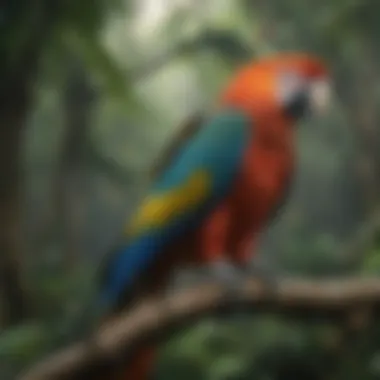
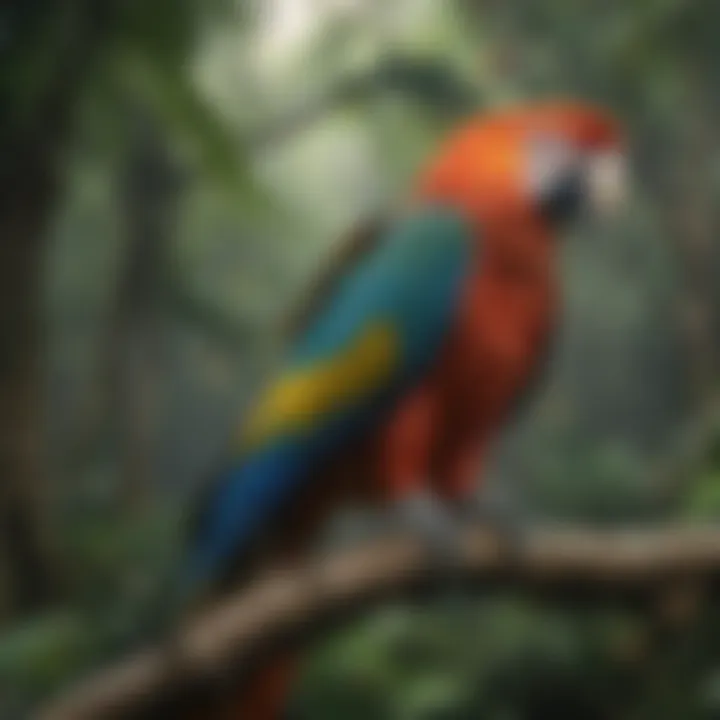
Intro
The Amazon rainforest is one of the most biodiverse places on Earth. Within its lush greenery, birds play a pivotal role in maintaining the balance of this complex ecosystem. While many may appreciate the beauty of birds, their significance extends far beyond mere aesthetics. To understand this relationship, one must explore the key functions that avian species fulfill within the Amazon and the pressing issues that threaten both their existence and the ecosystem as a whole.
In this article, we delve into the various dimensions that shed light on the intersection of birds and the Amazon, emphasizing their roles in promoting biodiversity, influencing environmental health, and contributing to cultural narratives. By examining these factors, we aim to underscore the urgency of conservation efforts and the protection of these vital ecosystems for future generations.
Understanding Your Pet
Birds, while often kept as pets, possess a set of unique characteristics and needs that require thoughtful consideration. Understanding these requirements is essential for their well-being and happiness.
Pet Behavior Basics
Bird behavior can be quite intricate. Many species are social creatures requiring stimulation and interaction. It is important to observe their routines to grasp their moods and needs.
Common Breed Characteristics
Different bird breeds exhibit distinct personality traits. Parrots, for example, are known for their intelligence and ability to mimic sounds. Finches are more low-maintenance and suitable for those who prefer a quieter companion. Understanding these traits can guide potential owners in making informed decisions.
Species-Specific Needs
Every bird species has specific requirements that must be understood for proper care. Some may require larger cages or specific diets rich in fruits and vegetables, while others thrive on seeds and grains. Researching individual species helps ensure their health and happiness.
The Roles of Birds in the Amazon
Birds in the Amazon contribute to ecological balance in several ways. They help in seed dispersal, pollination, and controlling insect populations. These natural processes are crucial for preserving the health of rainforest ecosystems.
Seed Dispersal
As birds consume fruits from various plants, they inadvertently assist in the distribution of seeds. This activity supports plant diversity and regeneration in the forest.
Pollination
Many birds, including hummingbirds, are vital pollinators for a range of tropical plants. This interaction not only benefits the flora but also sustains the animals that depend on these plants for food and habitat.
Pest Control
Birds also play a role in controlling insect populations. Their predatory behavior helps keep pest numbers in check, directly influencing the health of various plant species.
Climate Change and its Impact
Climate change presents a significant threat to the Amazon and its avian inhabitants. Altered weather patterns can disrupt breeding cycles and food availability for birds. This domino effect can have long-lasting repercussions on the ecosystem and its biodiversity.
Conservation Efforts
Conservation initiatives aimed at protecting both birds and their habitats are essential. These efforts often include habitat restoration, legal protections, and public awareness campaigns. Organizations such as the World Wildlife Fund (WWF) and BirdLife International work tirelessly to mitigate these threats and promote sustainable practices.
End
Understanding the intersection between birds and the Amazon is crucial for appreciating their ecological role. The health of these avian species is entwined with the well-being of the rainforest. In recognizing the importance of conservation efforts, we take a step toward preserving this irreplaceable ecosystem for the future.
Preamble
Birds hold a vital position in the Amazon ecosystem, serving as indicators of environmental health and contributors to biodiversity. Their complex relationships with the various layers of this rich habitat reveal much about both avian life and ecological integrity. This section will present core concepts about the interplay of birds and the Amazon, alongside their roles in maintaining the ecosystem.
Understanding Birds in the Amazon
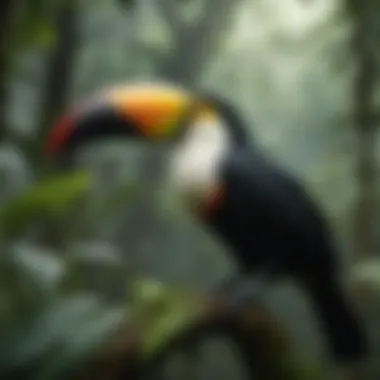
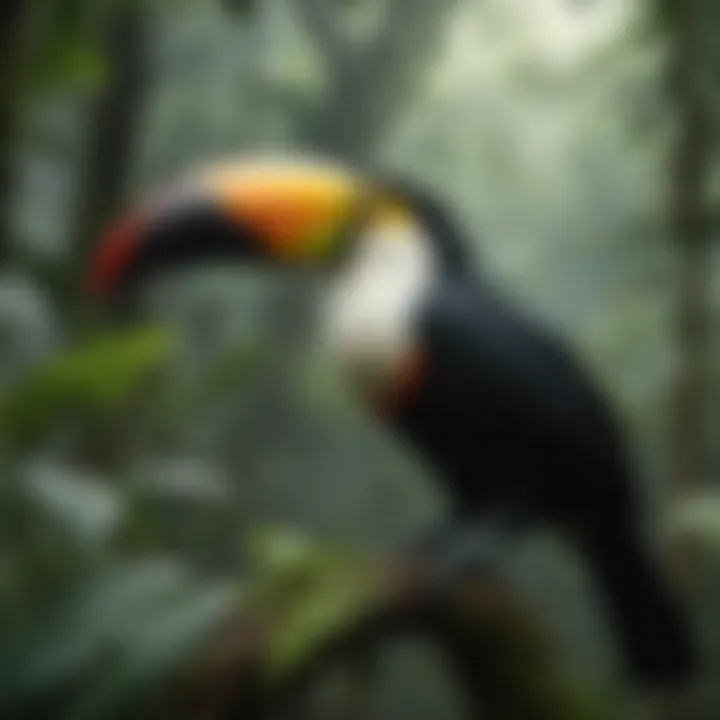
The Amazon Rainforest is home to approximately 1,300 species of birds, making it one of the most avian-diverse regions in the world. Each species possesses unique traits, contributing to the ecological balance in numerous ways. From the majestic Harpy Eagle to the colorful Macaws, birds fulfill essential functions such as pollination, seed dispersal, and pest control. Without them, the intricate web of life would face serious challenges.
Birds in the Amazon also provide insights into the broader health of the ecosystem. Changes in their populations can indicate environmental shifts, which may result from climate change or habitat destruction. Understanding this relationship helps in assessing the state of the Amazon and identifying urgent conservation needs.
Importance of the Amazon Rainforest
The Amazon Rainforest is often referred to as the
Biodiversity of Amazonian Birds
The Amazon rainforest is one of the most biodiverse regions on the planet, and its avian population plays a pivotal role in maintaining ecological balance. The biodiversity of Amazonian birds is crucial not only for their survival but also for the wellbeing of the entire ecosystem. As birds contribute to various ecological processes, understanding their diversity helps in preserving the intricacies of the rainforest environment.
Species Diversity
Aves of the Amazon
The Aves of the Amazon encompass an incredible variety of bird species, estimated to be over 1,300. This diversity includes everything from vibrant macaws to elusive owls. The key characteristic of these birds is their adaptability to various habitats within the rainforest. This adaptability makes them vital in illustrating the health of their environment.
Birds serve a significant role in seed dispersal and pollination. Additionally, their vibrant colors and diverse behaviors capture the interest of birdwatchers and researchers alike. The unique feature of Aves of the Amazon lies in their ability to thrive in multifaceted ecosystems, allowing them to occupy various ecological niches. This not only enhances their survival but also contributes to the overall health of the Amazonian ecosystem.
Endemic Species
Endemic Species within the Amazon rainforest are those that are not found anywhere else in the world. They represent a crucial part of the ecological fabric. A key characteristic of these species is their specialized adaptations that allow them to survive in the unique conditions of the Amazon.
Such species are essential for maintaining the region's ecological identity. The unique feature of endemic species often relates to their specific habitat preferences and behaviors, which can be sensitive to changes in the environment. This sensitivity often highlights the delicate balance within the ecosystem. Losing these species would mean irrevocably altering the natural heritage of the Amazon.
Habitat Preferences
Tropical Rainforest Ecosystems
The Tropical Rainforest Ecosystems of the Amazon provide a rich tapestry of habitats for various bird species. The key characteristic of these ecosystems is their dense vegetation and high humidity, which supports an abundance of life. This diversity facilitates interactions between species that thrive in such an environment.
The unique feature of tropical rainforests is the multiple layers of the canopy that provide different niches for avian species. Birds play various roles in dispersing seeds and shaping the plant communities within these layers. This multitier structure has advantages for biodiversity, as it allows different species to coexist by occupying various strata of the habitat without competing directly.
Riverine Ecosystems
Riverine Ecosystems are another crucial habitat for many avian species in the Amazon. These ecosystems consist of rivers, wetlands, and floodplains, offering distinct resources for many bird species. One key characteristic of riverine ecosystems is their dynamic nature, which is influenced by water flow, sediment deposition, and seasonal flooding patterns.
Unique features of riverine ecosystems include the rich array of fish and invertebrates that serve as food sources for birds. Also, the varied habitats along rivers provide nesting sites and foraging opportunities. This diversity can be advantageous; however, it also makes these ecosystems vulnerable to disturbances from human activity or climate change.
Ecological Roles of Birds
Birds in the Amazon play a varied and crucial role in maintaining ecological balance. Their presence influences the health and sustainability of the rainforest environment. As significant players in the ecological theater, birds affect plant life, animal populations, and overall ecosystem functionality. Their roles extend beyond mere beauty, impacting both the flora and fauna surrounding them.
Pollination and Seed Dispersal
One of the most important functions of birds is pollination. Many plant species in the Amazon rainforest depend on birds for this crucial process. When birds feed on nectar, they unknowingly transfer pollen from flower to flower. For instance, hummingbirds are known for their specialized feeding habits, which include frequent visits to blossoms. This behavior directly contributes to the reproductive success of many plant species. The relationship is mutually beneficial: birds gain nourishment, while plants ensure their propagation.
Birds also excel in seed dispersal, a vital ecological function. They consume fruits, and as a result, they transport seeds through their digestive systems. Once the seeds pass through their bodies, they are often deposited far from the parent plant, which aids in plant diversity and colonization of new areas. Species such as the toucan and macaw are particularly noted for this behavior. The loss of avian species could lead to diminished seed dispersal, affecting the vegetation and, consequently, the entire ecosystem.
Predatory Roles and Food Chains
Birds in the Amazon are not merely pollinators and seed dispersers; they also occupy critical positions as predators in the food chain. They help regulate insect populations, which, if left unchecked, can lead to significant crop and plant damage. Birds of prey like the harpy eagle maintain the balance by controlling smaller mammals and other birds. This predatory behavior ensures that no single species dominates the ecosystem, which promotes biodiversity.
Birds occupy various levels in the food web, influencing both herbivorous and carnivorous species. Their predation helps maintain a stable environment, preventing overpopulation and supporting a healthy ecosystem framework. The interconnectedness of these roles illustrates the delicate balance wherein each species plays its part, ultimately enhancing the resilience and vitality of the Amazon rainforest.
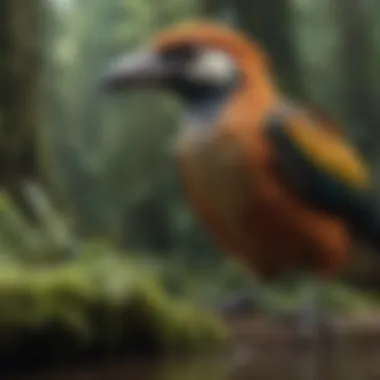
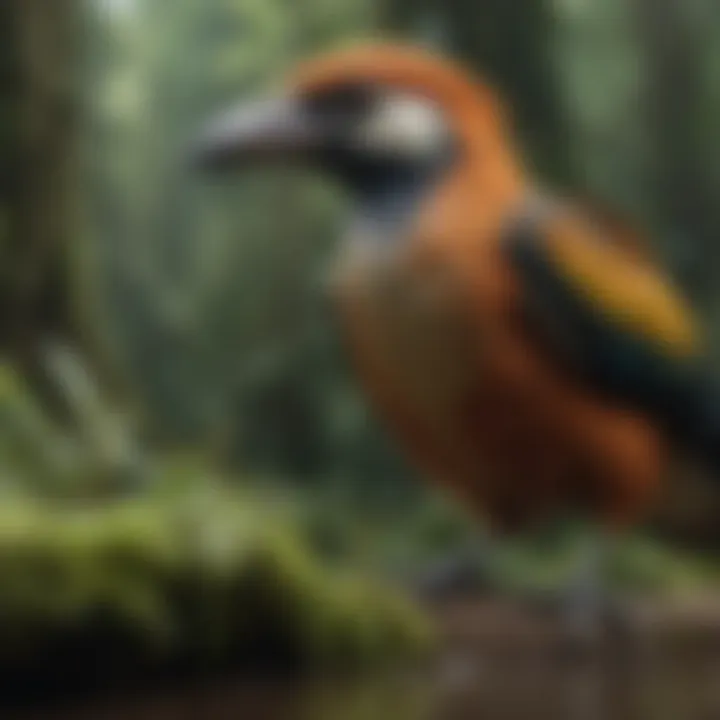
The ecological roles that birds play in the Amazon are essential for biodiversity. Their interactions with plants and other animals highlight the complex interdependence that sustains this rich ecosystem.
Overall, understanding the ecological roles of birds in the Amazon is fundamental to recognizing their value. Conservation efforts must prioritize these functions to maintain ecological integrity and ensure the survival of not only avian species but the entire rainforest ecosystem.
Cultural Significance of Amazonian Birds
The cultural significance of Amazonian birds is profound and multifaceted. Beyond their ecological roles, these avian species hold a prominent place in the mythologies, traditions, and artistic expressions of the indigenous people of the Amazon. This relationship is not merely based on observation; rather, it is deeply intertwined with history, culture, and identity. Understanding this connection offers insight into how birds influence the every day life of those who inhabit the rainforest.
Mythology and Symbolism
In various indigenous cultures of the Amazon, birds are often seen as messengers of the gods or symbols of freedom and resilience. Many tribes have specific birds that they revere. For instance, the harpy eagle is considered a protector and is revered by the Tupinambá people. The colors and songs of birds interweave with ancient tales told around fire. These stories often illustrate the creation of the world or explain natural phenomena, connecting the people's beliefs with their surroundings.
Furthermore, certain birds carry symbolic meanings. The macaw, with its vibrant plumage, embodies beauty and strength, while the owl symbolizes wisdom and protection. Each species contributes to a cultural narrative that emphasizes an intrinsic bond between the people and nature.
In many instances, birds are also seen as crucial for the well-being of the ecosystems. Their presence can signify a balanced environment. Thus, when these birds flourish, so do the communities around them. This connection deepens the respect for wildlife in cultural practices, fostering an environment where conservation is seen as carrying forward the traditions of honoring these remarkable creatures.
Art and Literature
The artistry inspired by Amazonian birds is vast and varied. However, this creativity is not limited to mere portrayals of birds in art; it extends into storytelling, songs, and rituals. Artists, both traditional and contemporary, depict birds in various mediums, from paintings to sculptures, reflecting their beauty and significance in Amazon life. Colors, shapes, and patterns often mimic the feathers of these birds, showcasing not only their appearance, but also the emotional bond shared with them.
Similarly, literature that emerges from this region frequently references avian life. Folktales about birds encapsulate lessons on morality, community values, and respect for nature. Writers and poets draw inspiration from the songs of birds, translating these sounds into verses celebrating life in the Amazon.
Birds also represent a theme of resilience in literature. They soar above challenges, serving as a reminder to people of the strength necessary to overcome adversity. Hence, the integration of birds in art and literature creates a layered narrative that enhances appreciation for both biodiversity and cultural identity.
The relationship between the indigenous peoples of the Amazon and their avian neighbors is not just ecological, it is existential, shaping lifestyles, beliefs, and artistic expression.
Through understanding the cultural significance of birds in the Amazon, one can appreciate that every chirp and flutter resonates with historical narratives and emotional connections. These birds serve as enduring reminders of the intertwined fates of all living beings in the rainforest.
Threats to Birds in the Amazon
Understanding the threats to birds in the Amazon is crucial for discerning the broader issues that affect not only avian species but also the entire ecosystem. The convergence of factors like deforestation, climate change, and illegal wildlife trade poses significant risks to these birds. These threats can lead to reduced populations, loss of species, and, ultimately, a decline in biodiversity. Recognizing and addressing these threats is essential for effective conservation efforts and for sustaining the rich tapestry of life in the Amazon rainforest.
Deforestation and Habitat Loss
Deforestation is one of the most pressing concerns regarding the survival of birds in the Amazon. The vast expanse of this rainforest has been under constant threat due to logging, agriculture, and urban expansion. Each tree cut down results in the loss of habitat for countless species.
Some birds depend on specific tree species for nesting or foraging. When vast areas are cleared, these birds may struggle to find suitable habitats. As forests disappear, so does the availability of food sources. The following points summarize the impact of deforestation on Amazonian birds:
- Reduced nesting sites: Many bird species rely on tree cavities or foliage for nesting, which become scarce as trees are removed.
- Fragmented habitats: Deforestation creates isolated patches of forest, making it difficult for birds to migrate or find mates.
- Loss of biodiversity: The decrease in bird populations can create a ripple effect, disrupting the balance of the entire ecosystem.
Addressing deforestation requires collaborative efforts among governments, organizations, and local communities to promote sustainable practices and restore affected areas.
Climate Change Impacts
Climate change represents another significant threat to birds in the Amazon. Changes in temperature and rainfall patterns can disrupt the delicate balance that governs ecosystems. For instance, birds may find it challenging to adapt to new climates, which can affect their breeding cycles and migration patterns.
The implications of climate change on these birds include:
- Shift in food availability: A change in plant species due to varying climatic conditions can result in a mismatch between food sources and bird feeding habits.
- Altered migration patterns: Birds that migrate may struggle to reach their destinations if weather patterns become unpredictable.
- Increased vulnerability: Extreme weather events can lead to habitat destruction, leaving birds exposed and unable to survive.
Research indicates that proactive measures are necessary to slow down climate change and mitigate its impacts on avian life.
Illegal Wildlife Trade
The illegal wildlife trade remains a significant concern for birds in the Amazon. Many species are targeted due to their beauty or rarity. This trade threatens both individual species and biodiversity as a whole.


Some key points regarding the illegal wildlife trade include:
- Overexploitation: Birds captured for the pet trade can face a high mortality rate during capture and transport.
- Loss of genetic diversity: Reduced populations can lead to inbreeding, weakening the overall gene pool.
- Decreased population resilience: With fewer birds in the wild, species may struggle to recover from environmental changes or other threats.
Efforts to combat the illegal wildlife trade must involve strict enforcement of laws and raising awareness about the impact of such actions on the Amazon's biodiversity.
"Protecting Amazonian birds is not just about saving individual species. It is about preserving the intricate web of life that sustains the entire ecosystem."
The threats to birds in the Amazon are multi-faceted and interconnected. Recognizing those threats is the first step to fostering an awareness of the need for effective conservation initiatives.
Conservation Efforts
Conservation efforts are vital within the discussions surrounding birds in the Amazon. The Amazon Rainforest serves as home to an astounding array of bird species, each contributing to the complexity of this ecosystem. As threats to this rich biodiversity increase, the focus on conservation has become paramount. These efforts not only aim to preserve avian life but also the intricate web of relationships that define the Amazon. This section will look at several key elements and benefits of conservation, emphasizing the role of protected areas, community involvement, and ongoing research.
Protected Areas and Reserves
Protected areas and reserves are established to safeguard critical habitats from destruction and degradation. In the Amazon, numerous protected areas have been designated to manage and conserve bird populations. These spaces play a significant role in ensuring the survival of many species that are endemic to the region.
The benefits of protected areas include:
- Habitat preservation: These spaces shield birds from the pressures of deforestation and urbanization.
- Biodiversity support: By providing a safe environment, they help sustain diverse bird populations, which in turn supports ecological balance.
- Research opportunities: Protected areas serve as living laboratories for scientists to study avian behaviors and conservation techniques.
- Tourism potential: Ecotourism can flourish in reserved regions, stimulating local economies while promoting conservation initiatives.
Community Involvement and Education
Engaging local communities in conservation efforts is crucial for successful outcomes. The people who live near these areas often possess invaluable knowledge about the land and its wildlife. By involving them in conservation measures, we ensure that efforts are both culturally appropriate and practical.
Key aspects of community involvement include:
- Education: Teaching families about the importance of birds and their ecosystems can foster a deeper respect and care for wildlife.
- Participation: Involving locals in monitoring bird populations and habitat restoration helps instill a sense of ownership and responsibility.
- Sustainable practices: Communities can adopt methods that support both their livelihoods and the conservation of bird habitats, such as sustainable farming and eco-friendly tourism.
Research and Monitoring
Systematic research and monitoring are integral to understanding the dynamics of bird populations in the Amazon. Continuous study enables conservationists to track the health of ecosystems and make informed decisions regarding management practices.
Important components of research and monitoring are:
- Data collection: Gathering data about both avian species and their habitats helps inform future conservation strategies.
- Adaptive management: Ongoing research allows for adjustments in conservation tactics based on observed results and changing conditions.
- Collaboration: Working with universities and research institutions facilitates knowledge exchange and resource sharing, enhancing overall conservation efforts.
Culmination
The topic of the conclusion serves as a critical component in bringing together the various threads discussed throughout the article. It highlights the relationship between birds and the Amazon, emphasizing their ecological importance, the threats they face, and the necessity for concerted conservation efforts.
The Future of Amazonian Birds
Looking ahead, the future of Amazonian birds is a matter of concern. Ongoing threats like deforestation and climate change pose significant risks. Many species are facing declining populations, which can disrupt the delicate balance within their habitats.
To safeguard these avian creatures, conservation strategies must adapt and evolve. Efforts should include the protection of critical habitats, like the Amazon rainforest. Programs aimed at restoring damaged ecosystems are also essential. By fostering sustainable practices in agriculture and forestry, we can work toward preserving these magnificent birds for future generations.
"The decline of birds in the Amazon signals a broader ecological crisis, making conservation an urgent priority."
Moreover, research plays a key role in assessing the health of bird populations. This includes monitoring breeding behaviors and migration patterns. Understanding these dynamics can direct more effective conservation strategies.
Call to Action for Conservation
The final call to action is vital. Awareness about the plight of Amazonian birds must be raised. Individuals and communities need to understand their role in supporting conservation.
There are several initiatives that people can engage with:
- Volunteer for local conservation projects: Many organizations rely on public support.
- Educate others: Sharing knowledge about the significance of birds in the ecosystem encourages broader participation.
- Advocate for policies: Support local and international legislation aimed at environmental protection.
Public support is essential for effective conservation strategies. Each action, no matter how small, contributes to the preservation of avian populations.
In summary, the interaction between birds and the Amazon showcases both beauty and vulnerability. Our responsibility extends beyond mere observation. It is an obligation to protect this delicate ecosystem, ensuring that both birds and forests thrive together.







